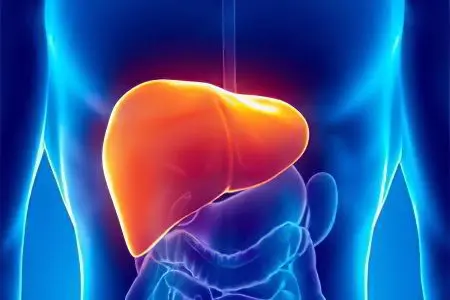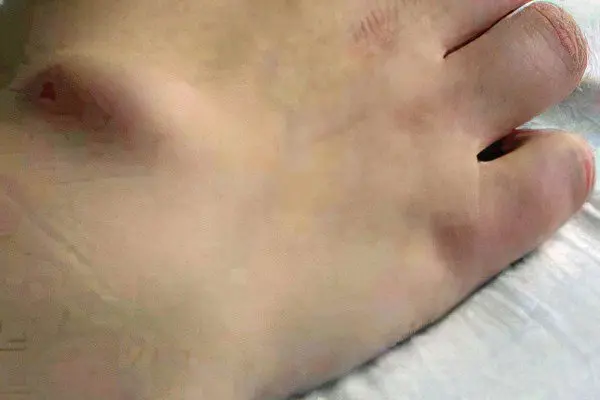Contents
The liver plays the role of a continuously working filter, which passes through itself all the blood circulating in the body. The task of the liver is to convert nutrients and medicines from the digestive system into chemical structures that can be used by the body further. The liver also performs other functions, such as preparing and removing toxins and other harmful substances from the body. The liver is made up of cells of different types, so it has the opportunity for the formation of tumors of various types.
Fibroma (from the Latin “fiber”) is a benign tumor type, consisting of connective tissue with a fibrous structure. This tumor can sometimes be combined with the growth of other types of tissues, which include muscle, vascular and glandular tissues. The occurrence of fibroma can occur on the mucous membrane, different parts of the skin, in the mammary gland, tendons, uterus, liver. A malignant type of tumor is called a fibrosarcoma.
Causes and symptoms of liver fibroma

The causes of the disease are poorly understood and there is no clear list of them. There are some factors that influence the development of liver fibroma. These include heredity, the use of hormonal medications, alcohol abuse, smoking. A negative factor is the consumption of a large amount of animal fats and the restriction in the diet of fiber contained in legumes, buckwheat and corn grits, vegetables, fruits. Although there is also no evidence of the influence of these causes on the development of fibroids.
In most cases, a small liver fibroma is not observed with any symptoms, so it is usually discovered by chance during a planned ultrasound scan. The large size of the fibroma in the liver is manifested by pain in the upper abdomen, which occurs during the mechanical pressure of the tumor on neighboring organs. There may be a feeling of nausea, there may be an eructation of air. The absence of specific signs to distinguish between benign and malignant tumors requires the use of additional signs.
Diagnosis of hepatic fibromas
Diagnosis of this disease begins with the patient’s complaints (how long ago the symptoms appeared and what exactly their manifestations), then the patient’s life is analyzed (the presence of bad habits, lifestyle and nutrition, existing diseases), after which the doctor analyzes the family history for hereditary diseases and conducts an objective inspection. To clarify the diagnosis, it is necessary to use data from a laboratory blood test (general, biochemical, tumor markers).
A clear idea of the presence of a tumor, its size and other parameters is given by ultrasound or MRI. In most cases, a study of the histological material obtained as a result of a puncture biopsy of the tumor is carried out. The examination may require such procedures as radiography, elastography, MRCP, additional consultations of a gastroenterologist and a therapist. All diagnostic measures are aimed at having clear confirmation of the good quality of the tumor under study and identifying concomitant diseases.
Treatment of liver fibroids
The course of the disease without symptoms requires constant monitoring by an oncologist, since liver fibroma has the ability to resolve on its own and there is no need for treatment. Cancellation of hormonal-type drugs also contributes to regression. Surgical intervention is prescribed only with a significant growth of fibroids with symptoms, when a rupture of the tumor can occur. Liver fibroma is extremely rare, grows slowly, its cells cannot move to neighboring organs (do not metastasize).
There is no specific method for the prevention of liver fibroma. As a preventive measure, it is recommended to follow certain nutritional principles: limiting animal fats, fried, spicy and smoked foods, a ban on fast food, and increasing the consumption of foods containing fiber. It is advisable to stop smoking and drinking alcoholic beverages and, if possible, not to take drugs containing hormones.
Tendon fibroma

Tendons (ligaments) are designed to play a specific role in movement. They connect a muscle or its active part to another part intended for motor function – usually a bone. The force with which the muscle fibers contract is concentrated in the tendon, then with its help it is transferred to the part of the body necessary for movement. Tendons are a special continuation of the muscles, they are based on connective tissue.
Fibroma is a benign type of formation formed by connective tissue fibers, sometimes in combination with overgrown tissues of other types: muscular, glandular, vascular. The occurrence of a fibroid tumor can occur in any part of the body (skin, mucous membrane, mammary gland, tendon, uterus) where there is connective tissue. Multiple manifestations of a fibroma are called fibromatosis.
Tendon fibroma, as a rule, does not degenerate into a malignant type of tumor. The causes of its occurrence are currently being studied, but observations fix the relationship between the occurrence of fibroids and hereditary factors, injuries or inflammatory processes in the tendons. A fibroid tumor has a slow growth, its significant increase can impede the movement and work of neighboring organs.
Diagnostic measures during the diagnosis are aimed at differentiating the tumor from cancers, which are characterized by the destruction of the surrounding tissue and rapid growth. The final diagnosis is made after a biopsy, the material of which undergoes a histological examination. Tendon fibroma is amenable only to surgical treatment performed on an outpatient basis with the use of local anesthesia. The operation according to modern methods minimally injures the tissues and reduces the rehabilitation period.









